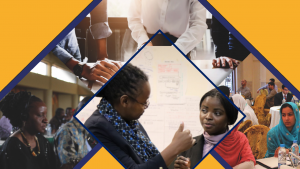
Moving beyond “the norm” for capacity development
Global thought leaders in evidence-informed policy recently came together to discuss the most significant lessons learnt about capacity development for evidence use, as well as how the sector needs to evolve to in order to adapt more effectively to a different set of global challenges. Emily Hayter shares some key themes.
Capacity development for evidence use is an important topic of discussion for those working on evidence-informed policy making (EIPM) as a strategic pillar for development. Capacity development has seen many iterations over the past few decades, with many successes, and a fair share of failures.
Throughout the years, INASP has benefited from regularly convening multiple actors to review, learn and reimagine this space. Against the backdrop of the Strengthening the use of Evidence for Development Impact (SEDI) initiative, a five-year programme (2019-24) working on increasing the use of evidence by policy makers in Uganda, Ghana, and Pakistan, we convened a round table discussion with five global EIPM thought leaders. As capacity development leads in SEDI, the INASP team wanted to know what these expert considered to be the most significant lessons learnt about capacity development for evidence use, as well as how the sector needs to evolve to in order to adapt more effectively to a different set of global challenges.
From capacity development to capacity sharing – rethinking our approach
Capacity ’building’ sometimes brings to mind a one-way transfer process where one set of actors build the capacity of others. Laurenz Langer, a Senior Researcher at the Africa Centre for Evidence (ACE) at the University of Johannesburg, warned that true capacity development has to move beyond an expert and recipient model. In order to do this, Langer suggests a shift in language as a first step in redefining the relationship between actors. Using language such as “capacity sharing… we get at a core tenet of how we define this field—co design and co creation” says Langer.
Capacity development has to focus more on collaboration and co-design at multiple levels within national policy-making environments if it is to be relevant for complex contexts. It needs to recognise that all actors have skills and knowledge that they bring to the table. It is only through collectively defining a problem, AND collectively designing its solution, that internalised capacity development begins to shape systems.
Through co-identifying issues and co-designing solutions, practitioners can recognise existing capacity and expertise to embed a sense of ownership across all levels of engagement and to ensure that evidence is reflective of the local environment it exists in.
Unpacking system actors for collaborative design
Understanding system actors and how they are related within complex contexts is a cornerstone of INASP’s own design and approach to capacity.
As Candice Morkel, Deputy Director of CLEAR at Wits University and former chair of the South African M&E Association, explains, focusing on the individual alone is an inadequate response to complex systems. It has become increasingly more important for capacity development partners to recognise that capacity development takes place at three pillars of engagement – individual, organisational and enabling environment (or the systems through which these pillars interact).
Adnan Khan, Professor in Practice in the school of public policy at LSE, characterised this as “one can look at [capacity development] for evidence use in the context of enhancing the capacity of the state to provide public services, regulate economic activity & enforce laws—in other words, enhancing the state’s capacity to deliver”.
The SEDI programme has demonstrated our commitment to enhancing state capacity through taking a capacity development approach that aims to “think and work politically”. To date, SEDI has intentionally worked to understand government entry points through conducting a comprehensive Political Economy Analysis (PEA) in Ghana, Pakistan and Uganda. Through the use of tools such as the Context Matters Framework, SEDI partners are moving towards better identifying contextualised capacity demand and working with government agencies to co-identify problems and co-design solutions.
Creating learner environments for continual capacity development
Co-identifying problems and co-designing solutions can only go so far if they are not embedded in environments where learning is just as important as using evidence.
One thing that previous learning has re-emphasised time and time again is that failing to account for the local context and failure to account for how systems interact with evidence in terms of demand for, and use of evidence, may undermine how evidence truly enters a country’s policy ecosystem. Having evidence is not enough if environments are not adapted to continual learning; Adnan Khan aptly described this as “the failure to learn”.
Evidence-informed policy making requires all system actors to be learning and adapting their approach to what works for policy through consistently using evidence as a foundation for building learning environments both at the individual and organisational level. This is as relevant for government actors as it is for EIPM practitioners. Langer advises implementers that by “being evidence informed themselves— [they must] come into the field, learn from existing experience, tacit knowledge as well as formalised [knowledge], and [ultimately] build on that.”
The opportunity not only exists to share capacity but actually embed learning into how we think about capacity development, using evidence both as an input and output of this process.
Ultimately, as Rose Oronje, Director of Public Policy and Communications at the African Institute for Development Policy (AFIDEP) describes, “the focus on embedded use of evidence [in SEDI] is really important as it is an opportunity to demonstrate that sustained use of evidence does not come from short consultancies here and there, [but rather through] challenging governments to look at this [evidence] in a systemic way, which means you have the relationships, the cultures, the mechanisms and you are investing in them incrementally to give you the evidence that you need.”
Capacity development has moved from being a simple transfer of knowledge to an adaptive process of looking at challenges from multiple perspectives and developing co-designed solutions that not only strengthen the use of evidence but also transform the environments where change happens. The SEDI project will soon be sharing more about its experience using evidence diagnostics as a foundation for sustainable changes in evidence use.
This blog post is part of a series led by INASP to analyse, engage with and learn from SEDI Capacity Development activities. SEDI is funded by UK’s Foreign, Commonwealth & Development Office.
Image credit: https://www.shutterstock.com/image-photo/ant-action-standing-bridge-unity-teamconcept-1118781845

 Previous Post
Previous Post Next Post
Next Post


